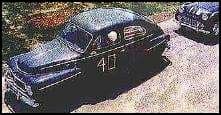
-----
Emissions from sulfuric acid anodizing & regulations
Q. Does anyone have information concerning air emissions from sulfuric acid anodizing operations? I've been told that in chromic acid anodize, 80-90% of electrical current is wasted dissociating water molecules creating the mist over the tanks. Is there a similar problem with sulfuric acid anodizing? Thanks
Scott F [last name deleted for privacy by Editor]Lockheed Martin
1995
A. Anodizing occurs because we split the water in the solution into hydrogen and oxygen, and the oxygen combines with the aluminum to oxidize it by forming aluminum oxides. So a lot of hydrogen gas is generated, creating mists -- both chromic and sulfuric anodizing processes gas a lot. The difference is that chromium is a known carcinogen with a long history of causing nasal perforations and chrome ulcerations. But the sulfuric acid is certainly irritating, and all anodizing tanks require local ventilation.

Ted Mooney, P.E.
Striving to live Aloha
finishing.com - Pine Beach, New Jersey
Ted can be retained for immediate
answers or long term project help
Regulations for Anodizing and Chromating Exhaust Fumes
Q. We are just now starting to vent the fumes with a system specifically for our process tanks (before this we just used part of our paint booth system to extract and exhaust the fumes on our anodize tanks).
I am looking at the different regulations that we need to stay within, but I'm stuck at a large stumbling block right at the start line! I need to know the "emissions rate" for our exhaust. How do I measure this? Can we do it with our in-house lab? Can we sample the exhaust and have it analyzed or do we need to have some one come here to analyze it?
Our processes are a standard sulfuric anodize w/ dichromate seal @ 190 °F, Boric Sulfuric anodize w/ a dilute seal @ 200 °F, Alodine 1500, Amchem #7/17 Cr deox, and an acid etch containing HN03 and Hydrofluoric (@ 1% of 48%).
Any suggestions?
Benjamin Jon Curto- Ponderay, Idhao, USA
2001
A. Benjamin,
I feel sorry for you as you are somewhat between a rock and a hard place.
If you go to a reputable mfgr. of mass transfer packing, they will ask WHAT are your concentrations of acids, WHAT are your airflows and then ask 'WHAT degree of efficiency of removal do you want?'. To the latter question were you to say l00%, then you'd have to sell the Company's Rolls Royce and Bentley ... after all, their job is to sell packing and they will be very helpful in telling you 'what' the diameter of your scrubber will be and 'what' the packing depth has to be and 'how much' alkaline reagent you'd have to use.
Coming back to all your 'chemicals', there is one point to consider regarding ambient or nearly ambient emissions of acids
...these emissions in MOST CASES are neither gaseous nor fumes. NEITHER. They consist of invisible low micron sized droplets. The exceptions are some of the many nitric compounds, but not all (a very unstable acid!)and partially HCl.... although with Assay applications these ordinary CT-120/2 eliminators meet specs re HCl and aqua regia.
In the Canadian province of Ontario the Air Management people (who parallel EPA on requirements) will demand to see a design drawing. They will then 'enter' this data into their computer and tell you ... it's OK ... it needs to be larger ... your stack height is too short
... you need to increase your alkali recirculation rate ... etcetera. In other words they'd be knowledgeably very helpful!
In British Columbia the authorities take a different tack. They don't care a hoot about the design ... only about the emissions and will demand on-site emission testing to comply with regulations.
In your case ... and may I suggest that all your ducting is made of PVC ... the approach I'd take (assuming you know all the airflow parameters) is to do some pre-empting work. If you did nothing at all, the authorities would come down on you like a brick shipyard. If you did something, something reasonably good, albeit inexpensive, you might well get away with it.
CASE HISTORY .... ALUMIDIZE Company (once called STAYSA) in Brantford, Ontario. l975 era. They were exhausting bright dip (at least 4% nitric) and sulfuric. The plant was situated in a narrow high valley necessitating quite a high stack with a good O.V.
I was experimenting to see if one could improve the capture efficiency of a l2 micron (blade type, horizontal airflow) mist eliminator by using a sprayed coalescer section (using PP mesh) before the eliminator. The sulfuric fumes, which are easy to control, bypassed the mesh and went directly into the eliminator. Because of the nature of bright dip, everyone said, EVERYONE, that one has to use an alkali to neutralize it.
A year goes by during which time the tough Air Management people OK the emissions, so I decide to revisit that plant and check on the alkali consumption as well as on the ventilation design, too.
The 'operator' of the alkali make-up tank is a recent Italian immigrant. I ask him how often is the alkali changed. 'No kapeech', he replies, 'only Aqua, aqua' !
So here we have a pretty common bright dip environment which passes all emission tests AND is located in a geographically bad news narrow valley ... and they are using W A T E R Ordinary tap water. Needless to say, thereon after all my bright dip designs used only
'aqua' and never alkali.
For the eliminators, try Munters in Florida. They have the German designed T-120/2 or try Allanco Environmental in New Westminster, B.C. who call their slightly improved design a CT-120/2.
I sincerely hope that this is of some help to you ... as with every battle (with the environment), a good pre-empt often works
Others follies teach us not
Nor much their wisdom preaches
Of sterling worth is what
Our own experience teaches. Author unknown.
Cheers !

Freeman Newton [dec.]
R.I.P. old friend (It is our sad duty to
advise that Freeman passed away 4/21/12)
Acidic Atmosphere in Our Anodizing Department
Q. We have a 700 s.f. anodizing shop, well ventilated, with about 5 active tanks. We are noticing acidic (pH 4-6) atmospheric conditions in the work areas. We believe that it may be coming from the Direct Fired Heater in our air makeup unit. Has anyone else had this problem?
Eric JonesProject Manager - Boise, Idaho, USA
2003
A. Well vented or not, I'd give ten to one that it's the anodizing tanks not the heater.

Ted Mooney, P.E.
Striving to live Aloha
finishing.com - Pine Beach, New Jersey
Ted can be retained for immediate
answers or long term project help
A. Or the deox/desmut tank. It is extremely difficult to capture 100% of the vapors off of the anodizing tank. Sometimes the first rinse tank will get to a pH of 1-2, so that might be a source also. What about drips?
James Watts- Navarre, Florida
![]() 10-1, eh Ted? How much $$ do you have? (We identified the heater as the cause) This heater is on our make-up air unit (26,000 cfm), it's winter, here in Idaho, and the combination of the moisture in the air, going through the gases from the gas burner (not stacked), created an acid rain effect. It was severe enough to cause slight pitting in our exposed aluminum parts, and turned our ph paper to a pink/red color overnight. (its amazing that no noticeable odor was present). We shut the heater down for a night (but not the blower), and the ph paper showed no change. We learned a lesson here.. that may help someone else out in the future.
10-1, eh Ted? How much $$ do you have? (We identified the heater as the cause) This heater is on our make-up air unit (26,000 cfm), it's winter, here in Idaho, and the combination of the moisture in the air, going through the gases from the gas burner (not stacked), created an acid rain effect. It was severe enough to cause slight pitting in our exposed aluminum parts, and turned our ph paper to a pink/red color overnight. (its amazing that no noticeable odor was present). We shut the heater down for a night (but not the blower), and the ph paper showed no change. We learned a lesson here.. that may help someone else out in the future.

Marc Green
anodizer - Boise, Idaho
! I've been wrong many times before and will be again, Mark. And I appreciate that reactions between water and organics can cause an acid condition--as is often seen in the solvent reservoirs of vapor degreasers. But I can't concede to things that are contrary to a lifetime of experience until the evidence gets reasonably compelling. I've been to very few anodizing and plating shops where the atmosphere isn't corrosive, ventilation or no, space heaters or no. But I can't recall any instance of a home, commercial installation, or industrial facility which did not use acid yet had a corrosive environment.
I am absolutely not saying you are wrong. You have presented enough evidence that I very much appreciate the feedback, and will keep it in the memory banks for the future. But I honestly can't concede 'case closed' based on one instance and one test; winds shift and I have seen the acid plumes from exhaust stacks sucked back into an air make-up unit one day and not the next.

Ted Mooney, P.E.
Striving to live Aloha
finishing.com - Pine Beach, New Jersey
Ted can be retained for immediate
answers or long term project help
|
|
A. Eric,  Freeman Newton [deceased] (It is our sad duty to advise that Freeman passed away April 21, 2012. R.I.P. old friend). Q. We followed this up by leaving the heater on one more time, and again, the ph paper showed color change. Our tanks are left covered every night before we go home for the day. Most home heaters are properly stacked to allow the gases (carbon monoxide, nitrogen dioxide) to escape, and not be pumped into the home. Our blower lacks such a stack. Our blower sits at ground level, while our exhaust fans are atop our 35 ft roof downwind of the blower). I installed carbon monoxide detectors as soon as we installed the blower (and I was informed that gasses weren't stacked) I've had peak level of 40 ppm (this was only one time) in the anodizing dept. I've worked in this business for long enough to recognize an acidic smelling environment (although I am probably de-sensitized), but we've had countless people in here who have said they smell nothing out of the ordinary. We are doing some in-depth air quality testing this week, I'll keep everyone posted. In the meantime..if anyone else has any other suggestions/probabilities of what may be causing our issue, I'd love to hear from them! All I know is that: heater on = pink ph paper, heater off = no change.  Marc Green anodizer - Boise, Idaho |
A. I believe that you can make some acid in a heater flame if there are chlorohydrocarbons in the burner air. Like HCl, for example. Do you have any degreasers or using some solvents in your shop? Can you test for chlorides?

Tom Pullizzi
Falls Township, Pennsylvania
Update We had some air samplers running in our dept for an 8 hour shift. We tested for HNO3, H2S04, and HF, with the blower operating (so I don't think we are sucking in our exhaust from the ano line) The results showed that we were way below the threshold for exposure over an 8 hour day. However, these tests did not/could not show what the actual pH of the air was that we are breathing. We have discontinued using the make-up air unit until we resolve this problem...we have left pH strips out, and since shutting off the make-up air unit, and the heater that works with it, we have seen no color change on the litmus paper. In answer to your question, Tom...no we do not use any solvent degreasers in the shop. The only solvent we regularly use is acetone ⇦ on eBay or Amazon [affil link] Flammable! . As far as chlorides go, the only one we use would be HCl, and that's only during some testing that we do on our anodic coatings . Is anyone aware of any test method that can be done to determine the acidity of the air (other than the crude ph paper)? Our labs are not aware of any such test. Also, does anyone know what the threshold is for breathing possible acidic air over an 8 hour period? I'm still holding tight to my "acid rain" theory, I just need a way to prove/disprove it.

Marc Green
anodizer - Boise, Idaho
(anodizer extraordinaire)
Luck & Regards,

Ted Mooney, P.E.
Striving to live Aloha
finishing.com - Pine Beach, New Jersey
Ted can be retained for immediate
answers or long term project help
A. Good afternoon:
The OSHA website lists permissible exposure limits (PEL) based on an 8 hour time weighted average for several common mineral acids. Go to
www.osha.gov/SLTC/pel/index.html ⇩
I think the info you're looking for is in Table Z1 and Z2 on this web page. Hope this is what you're looking for. And I hope you don't have to spend big $ for industrial hygiene testing.
- St Louis, Missouri
Ed. update: The above link is broken. Thankfully, the Internet Archive preserved a copy here ![]()
Please consider a donation to The Internet Archive.
A. Mark,
You said that your blower is at ground level and that your exhaust fans are on the roof, 35 feet up.
So my question is ... how high are the exhaust fan stacks? They should be at least 7 feet, presupposing there are no other and higher buildings nearby. Otherwise the roof eddy zone effect could cause some of the fumes to waft downwards. Anyhow, food for thought ... and my regards to your dawg.

Freeman Newton [dec.]
R.I.P. old friend (It is our sad duty to
advise that Freeman passed away 4/21/12)
A. We had air monitoring done in 2001 for an 8 hour period.
Limits were
1.0 mg/m3 permissible for Sulfuric
2.0 mg/ m3 permissible for Nitric
2.0 mg/m3 permissible for Sodium Hydroxide
My operators tested at 0.13 mg/m3 for Sulfuric None detected for Nitric 0.032 mg/m3 for Sodium Hydroxide
I run an etch recovery system and the caustic fumes can be pretty intense at times with the little exhausting we have that is why I had the testing completed. I hope this helps a little.
Bruce Pfaff- Wausau, Wisconsin
Pollution Control regulations and Measures in Sulfuric Acid Anodizing
Q. I want to know the pollution control regulations for sulfuric acid hard anodizing and what preventive measures are needed
Dipesh PatelHard Anodizing - Pardi, Gujarat, India
2004
A. Hi Dipesh !
Firstly, the air mgt standards for pollution control will surely VARY ... they vary sometimes in Canada from Province to Province and I'd imagine that India would certainly follow suit ... but yours are probably not nearly as onerous as the U.S. EPA specs. Check with your local authorities. OK?
The first prime requisite is good ventilation, i.e., a well designed ventilation system starting with the hood. The second one deals with air pollution ... and I'd suggest that you use a good 10 micron(capture) blade type horizontal mist eliminator. Don't use stainless. Use PVC. Don't waste your money on expensive mass transfer scrubbers.

Freeman Newton [deceased]
(It is our sad duty to advise that Freeman passed away
April 21, 2012. R.I.P. old friend).
Emissions from sulfuric acid anodizing
Q. I am an environmental engineer and I need to determine the air emissions from a sulfuric acid anodizing process. I am looking for emission factors, technical papers, or any article or document that has ever been published that could help me determine these emissions. I have looked in the USEPA TTNCIEF AP-42 manuals and found some emission factors for Chromic acid anodizing but none for sulfuric acid anodizing. based on the particular process of interest, I am expecting emissions of NaOH (Etch), H2SO4 and HNO3 (De-Ox), H2SO4 (anodizing) and acetic acid ⇦ on eBay or Amazon [affil link] (Seal) + possibly some other compounds in lesser amounts. I would appreciate any input on the matter as I am trying to avoid having to perform full-scale source testing (quite expensive).
Alex BallezStephen Lamming Associates Ltd - Toronto, Ontario, Canada
2005
A. Hi Alex,
May I suggest that first of all you have a gander in the archives at # 43/96, #
67/33, #
149/44
Then, perhaps, you might like to contact the local Air Management people who surely, surely could be of some help.
In a nutshell, there are two major chemicals ... sulfuric and nitric.
Sulfuric is dead easy and very inexpensive to collect. The nitric can present problems but I was always lucky because the fumes are low concentration and hence the exhaust airflow is 'high' on oxygen (i.e., air) and hence, as you know better than I (I hope), the bad NOx fumes ideally need a good (long) retention time plus oxygen so that they can revert to a scrubbable mode.

Freeman Newton [deceased]
(It is our sad duty to advise that Freeman passed away
April 21, 2012. R.I.P. old friend).
(affil links)

free pdf is currently available from academia.edu
A. The amount of fumes from sulfuric acid anodizing will be governed by the size of the load and the amount of air agitation used. Generic values mentioned in the ventilation spec, engineering books and the Metal Finishing Guide book work quite well.
James Watts- Navarre, Florida
Q, A, or Comment on THIS thread -or- Start a NEW Thread